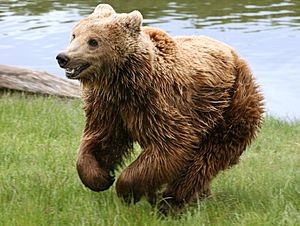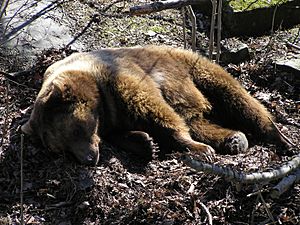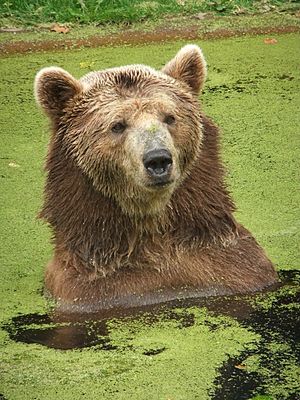Eurasian Brown Bear facts for kids
The Eurasian Brown Bear (Ursus arctos arctos) is a type of brown bear found across northern Eurasia. It's the national animal of several countries, like Finland!
Contents
Bears and Humans
Bears usually try to avoid people. However, they might attack if they are surprised, especially if they have cubs nearby. Bears also love food, so it's important not to leave food out in areas where bears live. This helps keep both bears and humans safe.
In Scandinavia, there have only been three recorded fatal bear attacks in the last 100 years. This is very few compared to some other places.
What They Eat
The Eurasian brown bear is an omnivore, which means it eats both plants and animals. Their diet includes:
- Berries, like blueberries
- Meat
- Honey
- Ants
- Grass, especially when other food is scarce
In the past, these bears ate a lot more meat. Long ago, about 80% of their diet was meat! But as their homes changed, they started eating less meat. Today, only about 10-15% of their diet is meat. They will eat sheep if they can.
History of Eurasian Brown Bears
Brown bears used to live in Britain until about 1000 AD. They disappeared because too many were hunted.
In Ancient Rome, Eurasian brown bears were used for fighting in big arenas. The strongest bears were thought to come from places like Caledonia (which is now Scotland) and Dalmatia.
Where They Come From
The oldest fossils of these bears are about 500,000 years old and were found in Choukoutien, China.
Scientists have studied their DNA to learn about their past. During the Pleistocene ice age, it was too cold for brown bears to live in most of Europe. They could only survive in a few places: Russia, Spain, and the Balkans.
Modern research shows that the Eurasian brown bear separated from other brown bears about 850,000 years ago. One group lived in Western Europe, and another group lived in Western Europe, Russia, Eastern Europe, and Asia.
Scientists have also found that European brown bears are divided into two main groups, called clades. One group is found in the Iberian Peninsula (Spain and Portugal) and the Balkans. The other group is found in Russia.
Bears in Scandinavia (like Sweden and Norway) have a mix of these two groups. The bears in southern Scandinavia likely came from populations in the Pyrenees mountains (between Spain and France) and the Cantabrian Mountains in Spain after the last ice age. The bears in northern Scandinavia probably came from the Finnish and Russian populations. Their ancestors might have survived the ice age in areas west of the Ural Mountains that were not covered in ice.
Where They Live Today
Even though the overall brown bear species is listed as "Least Concern" by the IUCN Red List of Threatened Species, some local groups of Eurasian brown bears are becoming very rare. The IUCN warns that "Least Concern does not always mean that species are not at risk."
Brown bears once lived across most of northern Eurasia. They are now extinct in Ireland and Britain. However, they still live in Northern Europe and Russia.
There is a small but growing group of at least 35 bears in the Pyrenees mountains, on the border between Spain and France. This group was once very close to disappearing. There are also about 250 bears in two groups in the Cantabrian Mountains in Spain. About 100 bears live in the Abruzzo, South Tyrol, and Trentino regions of Italy.
In Baltoscandia (around the Baltic Sea), bear populations are slowly growing:
Large groups of bears can be found in:
- Romania (around 6,000 bears)
- Slovakia (700-900)
- Bosnia and Herzegovina
- Croatia (1,200)
- Slovenia (500-700)
- Macedonia
- Bulgaria
- Poland
- Georgia
Smaller but still important groups live in Albania, Kosovo, Greece, Serbia, and Montenegro. In 2005, there were an estimated 200 bears in Ukraine.
The biggest brown bear population in Europe is in Russia. It has recovered after a time when many bears were hunted. Globally, the largest population is found east of the Ural Mountains, in the huge Siberian forests. Brown bears also live in smaller numbers in parts of Central Asia.
Other types of brown bears live in small, separate, and often threatened groups in Turkey, Iran, Afghanistan, Pakistan, parts of northwest India, central China, and on the island of Hokkaidō in Japan.
Bears in Culture
Eurasian brown bears often appear in European fairy tales and fables, especially those collected by Jakob and Wilhelm Grimm. These bears were once common in Germany and alpine areas like Northern Italy, Eastern France, and most of Switzerland.
The bear is a traditional symbol of Russian strength. It is also Finland's national animal. In Croatia, a brown bear is shown on the back of the Croatian 5 kuna coin, which has been made since 1993.
Images for kids
See also
 In Spanish: Oso pardo europeo para niños
In Spanish: Oso pardo europeo para niños






